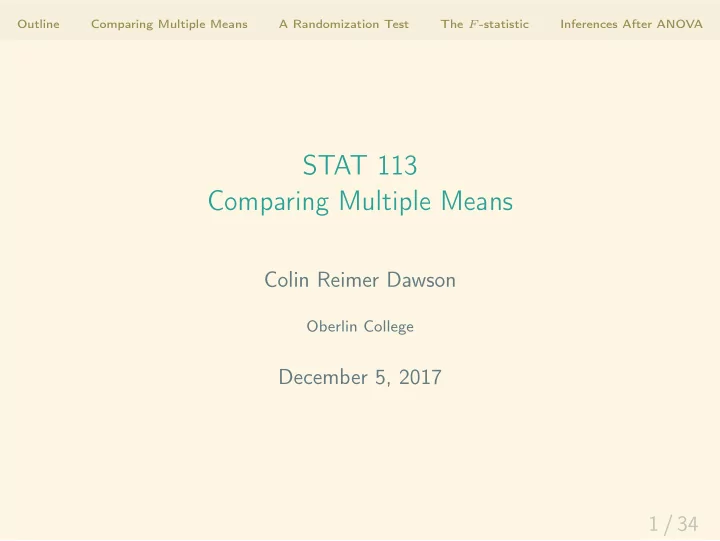

Outline Comparing Multiple Means A Randomization Test The F -statistic Inferences After ANOVA STAT 113 Comparing Multiple Means Colin Reimer Dawson Oberlin College December 5, 2017 1 / 34
Outline Comparing Multiple Means A Randomization Test The F -statistic Inferences After ANOVA Outline Comparing Multiple Means A Randomization Test The F -statistic Inferences After ANOVA 2 / 34
Outline Comparing Multiple Means A Randomization Test The F -statistic Inferences After ANOVA Exercise and Changes in Brain Size Researchers in China recently investigated whether different kinds of exercise/activity might help to prevent brain shrinkage or perhaps even lead to an increase in brain size (Mortimer et al., 2012). The researchers randomly assigned elderly adult volunteers into four activity groups: tai chi, walking, social interaction, and no intervention. Each participant had an MRI to determine brain size before the study began and again at its end. The researchers measured the percentage increase or decrease in brain size during that time. 4 / 34
Outline Comparing Multiple Means A Randomization Test The F -statistic Inferences After ANOVA Variables and Hypotheses 1. Here, the response variable (change in brain size) is quantitative, and the explanatory variable (activity group) is categorical. 2. A natural set of parameters to focus on is the typical response in each group. For example, focus on the four group population means of the change in brain size variable. 4. For activity and change in brain size to be associated, that would mean that the group distributions are not identical. In particular, we would expect the means to differ: H 0 : µ TaiChi = µ Walking = µ Social = µ Nothing H 1 : At least one µ differs from at least one other 5 / 34
Outline Comparing Multiple Means A Randomization Test The F -statistic Inferences After ANOVA The Data Brain <- read.file("http://colinreimerdawson.com/data/brain_size.txt") sample(Brain) %>% head() Treatment BrainChange orig.id 50 Walking 1.492 50 48 Walking 1.145 48 59 Social 0.276 59 84 None -1.347 84 74 Social 0.596 74 29 TaiChi 2.201 29 6 / 34
Outline Comparing Multiple Means A Randomization Test The F -statistic Inferences After ANOVA How does it look? bwplot(BrainChange ~ Treatment, data = Brain) 2 BrainChange 1 ● ● 0 ● ● −1 ● ● −2 −3 None Social TaiChi Walking dotPlot(~BrainChange | Treatment, data = Brain) −4 −2 0 2 −4 −2 0 2 None Social TaiChi Walking ● 10 ● ● ● 8 Count ● ● ● 6 ● ● ● ● ● ● ● ● ● ● ● ● ● ● ● ● ● 4 ● ● ● ● ● ● ● ● ● ● ● ● ● ● ● ● ● ● ● ● ● ● ● ● ● ● ● ● ● ● ● ● 2 ● ● ● ● ● ● ● ● ● ● ● ● ● ● ● ● ● ● ● ● ● ● ● ● ● ● ● ● ● ● ● ● ● ● ● ● ● ● ● ● ● ● ● ● ● ● ● ● ● ● ● 0 −4 −2 0 2 −4 −2 0 2 BrainChange 7 / 34
Outline Comparing Multiple Means A Randomization Test The F -statistic Inferences After ANOVA Descriptive Stats favstats(BrainChange ~ Treatment, data = Brain) Treatment min Q1 median Q3 max mean sd n 1 None -2.034 -1.16875 -0.585 0.9725 2.011 -0.2401250 1.2584309 24 2 Social -1.359 0.00750 0.596 0.8060 1.796 0.4056296 0.6968969 27 3 TaiChi -1.829 0.00500 0.449 0.9870 2.201 0.4710690 0.8557466 29 4 Walking -3.470 -1.05850 -0.026 0.9710 1.833 -0.1503333 1.3868388 27 missing 1 0 2 0 3 0 4 0 8 / 34
Outline Comparing Multiple Means A Randomization Test The F -statistic Inferences After ANOVA A Randomization Test • We are testing for an association. We can randomize by randomly pairing responses and group assignments. Randomly re-group the data. • But how to we measure deviation from expectations under H 0 ? 10 / 34
Outline Comparing Multiple Means A Randomization Test The F -statistic Inferences After ANOVA Possible Test Statistics • Take ¯ x largest − ¯ x smallest • Take average of all pairwise absolute differences: | ¯ x 2 − ¯ x 1 | + | ¯ x 3 − ¯ x 1 | + | ¯ x 4 − ¯ x 1 | + | ¯ x 3 − ¯ x 2 | + | ¯ x 4 − ¯ x 2 | + | ¯ x 4 − ¯ x 3 | 6 • Take standard deviation of sample means: �� G x g − ¯ x ) 2 g =1 (¯ ¯ G − 1 x g = mean of group g , ¯ where ¯ ¯ x = mean of means, and G = number of groups 11 / 34
Outline Comparing Multiple Means A Randomization Test The F -statistic Inferences After ANOVA Possible Randomization Test: Std. Dev. of Means ## Construct the randomization distribution Random.sd.of.means <- do(10000) * mean(BrainChange ~ shuffle(Treatment), data = Brain) %>% sd() ## Compute the observed variance of means obs.sd.of.means <- mean(BrainChange ~ Treatment, data = Brain) %>% sd() 12 / 34
Recommend
More recommend